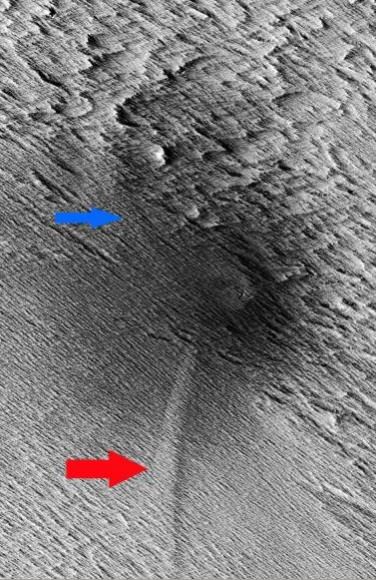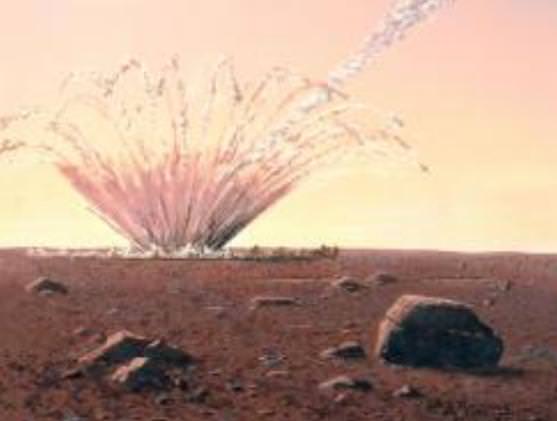[/caption]
They are headed toward the surface like a speeding freight train… and running ahead of them is a shockwave. Just like a loud sound can trigger a snow avalanche here on Earth, the shockwave of a meteorite crashing through the Martian atmosphere could trigger dust avalanches on the surface before an actual impact.
According to a study led by University of Arizona undergraduate student, Kaylan Burleigh, there is sufficient photographic evidence to prove that incoming meteorites are producing enough energy to impact the surface environment just as much as the strike. Mars’ thin atmosphere also contributes, since the lesser density means most meteorites survive the trip to the surface. “We expected that some of the streaks of dust that we see on slopes are caused by seismic shaking during impact,” said Burleigh. “We were surprised to find that it rather looks like shockwaves in the air trigger the avalanches even before the impact.”

“The dark streaks represent the material exposed by the avalanches, as induced by the airblast from the impact,” Burleigh said. “I counted more than 100,000 avalanches and, after repeated counts and deleting duplicates, arrived at 64,948.”
As Burleigh took a closer look at the distribution of avalanches around the impact site, he noticed a lot of relative things, but the most important was a curved formation described as scimitars. This was a major clue as to how they were formed. “Those scimitars tipped us off that something other than seismic shaking must be causing the dust avalanches,” Burleigh said.
Just as a freight train sends a rumble before it arrives, so does the incoming meteor. By using computer modeling, the team was able to simulate how a shockwave could form and match the scimatar patterns to the HiRISE images. “We think the interference among different pressure waves lifts up the dust and sets avalanches in motion. These interference regions, and the avalanches, occur in a reproducible pattern,” Burleigh said. “We checked other impact sites and realized that when we see avalanches, we usually see two scimitars, not just one, and they both tend to be at a certain angle to each other. This pattern would be difficult to explain by seismic shaking.”
Because there are no plate tectonics, nor water erosion issues, these types of findings are very important to understanding how many Martian surface features are formed. “This is one part of a larger story about current surface activity on Mars, which we are realizing is very different than previously believed,” said Alfred McEwen, principal investigator of the HiRISE project and one of the co-authors of the study. “We must understand how Mars works today before we can correctly interpret what may have happened when the climate was different, and before we can draw comparisons to Earth.”
Original Story Source: University of Arizona News.


Reading about meteorite-induced shockwaves, “airblasts” and seismic shaking, I immediately thought about the “Tunguska Event” of 1908 in central Siberia: 1927 Soviet scientific expedition discovered “a landscape of devastation: millions of trees from the Taiga forest were uprooted for miles around”, 830 square miles of forest were flattened, in “a circle of 25 kilometers around the epicenter”, all trees “pointing away from the apparent point of impact”.
The actual impact site was never found, and it was realized that it had been an above ground atmospheric explosion, which “caused a massive ‘airburst’, … strong enough to flatten trees for dozens of kilometers in ever direction.”
Though this fascinating insight of features around impact sites on Mars is not quite the same, the physics at work may be somewhat similar: “supersonic” air passage generating an “airblast”, inducing seismic shockwaves (apart from actual impact), triggering Martian dust avalanches – or flattening Earth forests.
From Planetary Society piece 04.15.08
“As the space rock blazes through the atmosphere, it leaves behind it a hot low-density wake of air mixed with rock vapor, which can reach far behind the rock and shoot out into space [ “pancaking’ effect, and “firey jets” shooting out of atmosphere, dramatically seen in Comet Shoeaker-Levy Jupiter impacts ]. Then, once it reaches the airburst altitude, the mass of the asteroid fragments and vaporizes in a massive explosion, and takes the form of a giant fireball of vaporized rock and air. Even then – and this is the chief difference between Boslough’s and Crawford’s simulation and previous ones [ International Journal of Impact Engineering { ’08 } Mark Boslough and David Crawford of the Sandia National Laboratories in New Mexico ] – the fireball continues speeding towards the ground, driving a massive shockwave before it. At this point the fireball is moving much slower than the asteroid had been prior to the explosion, but it is still traveling at supersonic speeds. And it is the fireball and its accompanying shockwave, say the article’s authors, not the initial bomb-like explosion, which cause most of the damage on the ground.
“When it reached the airburst altitude of around 12 kilometers, the asteroid vaporized and transformed into a giant fireball but continued moving towards the ground at supersonic speed. All the while, it was driving a massive shockwave before it.
Upright trees at epicenter — “In the event, the Tunguska fireball did not reach the surface. …the shockwave traveling before the fireball did reach the ground, bringing with it high winds that flattened trees for dozens of miles in each direction in the taiga forest. That is what [ Leonid ] Kulik and his companions saw when they arrived at the site 19 years later [1927].
“… it was not a point explosion at the airburst altitude that caused the damage, but the fireball and shockwave that continued moving towards the surface. At a height of around 4 kilometers, the simulations show, the fireball came to a stop, but the shockwave continued on. It was the shockwave, not the explosion at the airburst altitude and not even the streaking fireball, which was responsible for most of the devastation in the forest.”
http://planetary.org/programs/projects/targetearth/tunguska.html